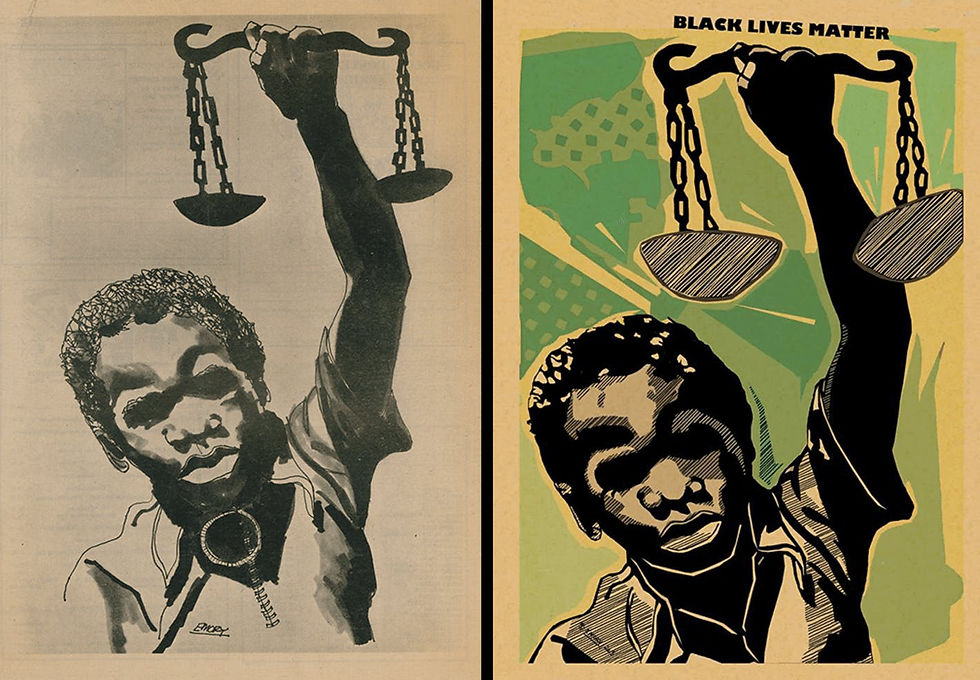- ranitapw
- Dec 28, 2022
- 3 min read
Updated: Jun 11, 2024

This lesson idea invites a close reading of Bhimayana to open up constructive conversations towards critically understanding caste, and encourage an introduction to the writings, life and work of Dr. B.R. Ambedkar. This lesson plan was constructed based on the structure of a workshop we conducted in December 2022. Read a report on it here.
Idea for an introduction: (15–20 mins)
The teacher puts together a thought-provoking collage of images/ a multimedia short presentation that compiles varied instances of Ambedkar being invoked in the present day. Students could then be asked to closely read the collage/presentation and attempt to identify the context of the images and in the process, also share their existing associations with and understandings of Ambedkar's work.

In the History for Peace workshop we did, this is the basic collage we put together that allowed us to engage the participants in questions such as 'What logic do you think lay behind placing the three images on the right in serial order', or 'If, as you say, Ambedkar was only a champion of Dalits' rights, why is his portrait being upheld in an anti-Citizenship Amendment Act (CAA) demonstration?
Materials required:
At least one copy of Bhimayana, available to purchase here.
Colour xeroxes of the text selections from Bhimayana listed under Step 1 below
Chart papers, glue, scissors, miscellaneous stationery for the story board
Activity: 45 min
1. Students are divided into groups. Each group is assigned one of the below selections from Bhimayana.
Pg 18–21; 24–25
Pg 33–36; 41, 47
Pg 48–53
Pg 60–73
2. Next, students are offered a handful of relevant quotes from the text to pick from. Each group may pick more than one. For the workshop, our quotations also included Ambedkar's quotations as used in Bhimayana. Here are two we used.
'A lot of people say we exaggerate the allegations of Hindu injustice, oppression and tyranny. The doctor who treated the untouchable woman, for instance, felt no qualms of conscience in setting aside the code of conduct which is binding on his profession. The Hindu would prefer to be inhuman rather than touch an untouchable. In Baroda I found that a person who is an untouchable to a Hindu is also untouchable to a Parsi. And in Daulatabad I discovered that a person who is an untouchable to a Hindu is also an untouchable to a Mohammedan.' - Bhimayana, pg. 88.
'Ambedkar campaigned for a just society all his life, from the time he launched an anticaste newspaper in 1920, through the years he spent studying at the London School of Economics and qualifying at Gray’s Inn to be a lawyer, through the years he spent practising law at the Bombay High Court. He wanted the untouchable castes to be politicized, to fight for their rights, not to have to rely on the kindness and good intentions of upper caste Hindus. He launched organizations to raise political awareness and to build schools and libraries for the most marginalized castes. Gandhi had different priorities—he was more concerned with India’s freedom from British rule than with the transformation of Hindu society.' - Bhimayana, pg. 88.
3. Construct your storyboard! Each group of students is to make a pictorial map/storyboard illustrating the links they identify between the quote and any of the themes they read in their assigned text selection. They could also bring into the storyboard any echoes they find of these connections, such as in the Indian Constitution or from contemporary everyday life or in the arts.
Question for students to reflect on and discuss: Do you notice anything that is distinctive to this form/ kind of discrimination [caste] when compared with other forms of identity based discrimination?
4. Groups then present/display their storyboards for each other's viewing, followed by an open discussion led or facilitated by the teacher, picking on the themes that come up/they would like to focus on.
Here's a sample of a storyboard two students made at the workshop:

Note for the teacher:
If the teacher would particularly like to focus on the form of Bhimayana, a discussion could be prompted with: Would you describe Bhimayana as a comic? This can be done only once students have been offered enough time to familiarize themselves with the book.
A discussion around the prompt could be used to segue into Part 4 of the book, 'The Art of Bhimayana' and the section titled 'A Digna for Bhim'.
Do let us know in comments what you think of the lesson idea! We'd especially love to hear if you try this out in your classroom, how you adapt it, how your students respond, etc.







Comments